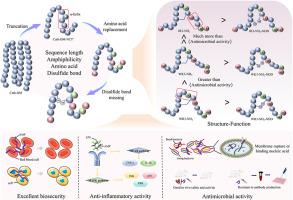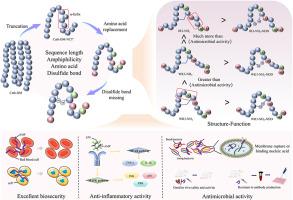Design and function analysis of novel antimicrobial peptides derived from Cathelicidin-DM: Insights into structure-function relationships
IF 5.9
2区 医学
Q1 CHEMISTRY, MEDICINAL
引用次数: 0
Abstract
The increasing threat of bacterial drug resistance calls for effective solutions, and antimicrobial peptides (AMPs) hold great promise. However, the connection between their structure and function remains unclear. The study of the structure-function relationship and other basic issues of AMPs is a guarantee for the development of safe, effective and clear mechanism of therapeutic drugs or active biomaterials. The aim of this study was to develop new antimicrobial candidate molecules and further elucidate the structure-function relationship of AMPs. In this study, more than 20 AMPs derived from Cathelicidin-DM were designed in terms of sequence size, amino acid composition, amphiphilicity and amidation. And then the antimicrobial activity in vitro/vivo, structure of peptides, safety and stability assessment, antimicrobial mechanism, anti-inflammatory activity, and in vivo toxicity were evaluated, and the relationship between structure and function of AMPs was analyzed. The results showed that the hydrophobicity amino acid substitution is of great significance to improve the biological activity of AMPs. Overall, our research uncovers the potential link between the function and structure of AMPs, laid the foundation for the development of AMPs drugs and biomaterials.


从Cathelicidin-DM衍生的新型抗菌肽的设计和功能分析:结构-功能关系的见解
细菌耐药性日益严重的威胁需要有效的解决方案,抗菌肽(AMPs)具有很大的前景。然而,它们的结构和功能之间的联系尚不清楚。研究amp的结构-功能关系等基本问题,是开发安全、有效、机制明确的治疗药物或活性生物材料的保障。本研究旨在开发新的抗菌候选分子,进一步阐明抗菌肽的结构-功能关系。本研究根据序列大小、氨基酸组成、两亲性和酰胺性设计了20多个从Cathelicidin-DM衍生的AMPs。然后对抗菌肽的体外/体内抗菌活性、肽结构、安全性和稳定性评价、抗菌机制、抗炎活性、体内毒性进行评价,并分析抗菌肽结构与功能的关系。结果表明,疏水氨基酸取代对提高抗菌肽的生物活性具有重要意义。总的来说,我们的研究揭示了amp的功能和结构之间的潜在联系,为amp药物和生物材料的开发奠定了基础。
本文章由计算机程序翻译,如有差异,请以英文原文为准。
求助全文
约1分钟内获得全文
求助全文
来源期刊
CiteScore
11.70
自引率
9.00%
发文量
863
审稿时长
29 days
期刊介绍:
The European Journal of Medicinal Chemistry is a global journal that publishes studies on all aspects of medicinal chemistry. It provides a medium for publication of original papers and also welcomes critical review papers.
A typical paper would report on the organic synthesis, characterization and pharmacological evaluation of compounds. Other topics of interest are drug design, QSAR, molecular modeling, drug-receptor interactions, molecular aspects of drug metabolism, prodrug synthesis and drug targeting. The journal expects manuscripts to present the rational for a study, provide insight into the design of compounds or understanding of mechanism, or clarify the targets.

 求助内容:
求助内容: 应助结果提醒方式:
应助结果提醒方式:


